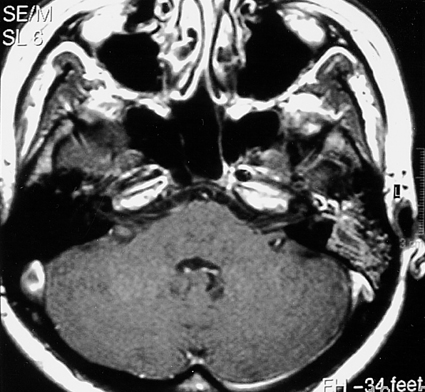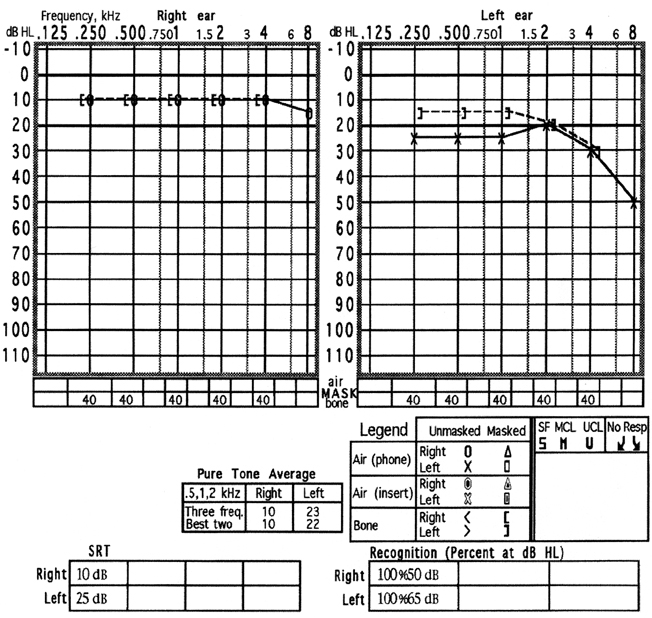Yonsei Med J.
2005 Feb;46(1):161-165. 10.3349/ymj.2005.46.1.161.
A Case of Tympanogenic Labyrinthitis Complicated by Acute Otitis Media
- Affiliations
-
- 1Department of Otolaryngology, Chonnam National University Medical School, Gwangju, Korea. chulsavio@hanmail.net
- 2Department of Otolaryngology, Inje Medical School, Ilsan Pak Hospital, Korea.
- 3Department of Otolaryngology, Cathay General Hospital, Taipei, Taiwan.
- KMID: 2158128
- DOI: http://doi.org/10.3349/ymj.2005.46.1.161
Abstract
- Widespread use of antimicrobial drugs in the management of otitis media has significantly reduced the incidence of labyrinthitis nowadays. Cases of tympanogenic labyrinthitis following acute otitis media have rarely been reported in recent literature on otolaryngology. We report an unusual case of tympanogenic labyrinthitis that presented with sudden sensorineural hearing loss (SNHL) following acute otitis media in an adult who had no previous otological complaints. An audiogram revealed SNHL with pure tone threshold of 43.7 dB in the left ear. MRI was helpful to identify the inflammatory change of the membranous labyrinth. The patient's hearing returned to normal after treatment. The definite diagnosis of serous labyrinthitis was established retrospectively.
Keyword
MeSH Terms
Figure
Reference
-
1. Youngs R. Ludman H, Wright T, editors. Complications of suppurative otitis media. Disease of the Ear. 1998. 6th ed. New York: Oxford University Press Inc;398–415.2. Wetmore RF. Complications of otitis media. Pediatric Am. 2000. 29:637–647.3. Schuknecht HF. Infections: labyrinthitis. Pathology of the ear. 1993. Pennsylvania: Lea & Febiger;211–216.4. Dew LA, Shelton C. Cummings CW, Fredrickson JM, Harker LA, Krause CJ, Richardson MA, Schuller DE, editors. Complications of temporal bone infections. Otolaryngol Head Neck Surg. 1988. 3rd ed. St Louis: Mosby;3047–3075.5. Ludman H. Kerr AG, editor. Complications of suppurative otitis media. Scott-Brown's Otolaryngology. 1987. 5th ed. London: Butterworths;264–291.6. Mafee MF. MR imaging of intralabyrinthine schwannoma, labyrinthitis and other labyrinthine pathology. Otolaryngology Clin North Am. 1995. 28:407–430.7. Seltzer S, Mark AS. Contrast enhancement of the labyrinth on MR scans in patients with sudden hearing loss and vertigo: evidence of labyrinthine disease. AJNR. 1991. 12:13–16.8. Rappaport JM, Bhatt SM, Burkard RF, Merchant SN, Nadol JB Jr. Prevention of hearing loss in experimental pneumococcal meningitis by administration of dexamethasone and ketorolac. J Infect Dis. 1999. 179:264–268.
- Full Text Links
- Actions
-
Cited
- CITED
-
- Close
- Share
- Similar articles
-
- A Case of Acute Suppurative Labyrinthitis Complicated by Chronic Otitis Media
- A Case of Acute Serous Labyrinthitis Complicated by Chronic Otitis Media Showing Atypical Nystagmus Pattern
- A Case of Scala Vestibuli Cochlear Implantation in Tympanogenic Labyrinthitis Ossificans
- A Case of Acute Coalescent Mastoiditis with Otogenic Cerebellar Abscess due to Acute Otitis Media
- Tuberculous Otitis Media with Facial Paralysis Combined with Labyrinthitis





